Grishneshwar Jyotirling ( Marathi:ग्रीश्नेश्वर ज्योतिर्लिंग, Hindi:ग्रिश्नेश्वर ज्योतिर्लिंग) is located at a village called Verul which lies at a distance of 11 km from Daulatabad and 30 kms from Aurangabad, Maharashtra. On this holy pilgrimage of the JyotirLingas of Lord Shankara, the last one, with out which the pilgrimage will not be considered as complete.
Grishneshwar Temple - Abstract
Kusumeswarar/Grineshwar: Jyotirling
Important Festival(s):
-
Mahashivaratri
-
Shravan Mela
-
Vaikunth Chaturdashi
.
Grishneshwar temple timings
Temple Timings Open 5.30 am – 9.30 pm
During Shravan (Aug-Sep): 3 am – 11 pm
.
- The Gharishneshwar Temple was built between the years 1765 and 1795.
- Grishneshwar is an ancient pilgrimage site revered as the abode of one of the 12 Jyotirlingas of Shiva. It is located at a distance of 11 km from Daulatabad near Aurangabad in Maharashtra. Daulatabad was once known as Devagiri. Located nearby are the popular tourist attractions Ellora – featuring ancient rock cut monuments from the 1st millennnium CE, and Ajanta known for its exquisite cave paintings again from the 1st millennium CE.
- The Grishneswar temple was constructed by Ahilyabhai Holkar who also re-constructed the Kasi Viswanatha temple at Benares and the Vishnu Paada temple at Gaya. Grishneshwar is also known as Ghushmeshwar.
- The temple is also known by several other names like Kusumeswarar, Ghushmeswara, Grushmeswara and Grishneswara.
- The Grishneshwar temple has its root in several legendary tales. As the legendary tale goes, a devotee by the name of Kusuma used to offer prayers to Lord Shiva by dipping the Shivalinga in a water tank. When her son was killed by her husband’s first wife out of jealousy, she continued her rituals and one day Lord Shiva appeared before her, answered her prayers by miraculously restoring her son’s life.
Architecture:
- The temple is built of red rocks which call for the alluring look that it delivers. The temple is composed of a five tier shikara which account for the attractive look thatit renders. Built in the 18th century the temple is 240 x 185 feet tall and cubicle in shape.
- Halfway up the temple, Dashavataras are carved in red stone. These are beautiful to look at. There are also other beautiful statutes carved out.
- A court hall is built on 24 pillars. On these pillars there are wonderful carvings. The scenes and paintings are beautiful.
- The Garbhagriha measures 17ft x 17 ft. The Lingamurty faces eastward.
- The Shivlinga resides inside the inner chamber of the temple. Outside this chamber a large statue of Nandi is present.
- Covering Nandi is the Sabha Mandap of the temple. It occupies the major portion of the temple and offers seats made from stone. Various tales can be seen carved on the pillars of the Sabha Mandap. These carvings feature fine details and notable artistic ability.
- The exterior walls of the temple are full of various carvings. Several mythological tales are carved here. Amongst these the statues showing ten incarnations of Lord Vishnu stand out.
- The conical top of the temple, which was probably built later, also has carvings with fine details. The figures here are masterfully carved and possess very expressive gestures.
- The temple has a gilded crest made of copper. Resting inside a square shaped ground, having pavement and a surrounding stonewall, and the Ghrishneshwar temple is a fine example of ancient building work.
Airways: Aurangabad Airport is nearest to Grishneshwar Temple. It is approximately 29 Km from the Grishneshwar Temple.
Railways: Aurangabad Railway station is nearest to temple but Manmad is major railway station nearest to Grishneshwar Temple. Grishneshwar Temple is approximately 30 KM from the Aurangabad and 140 KM from the Manmad Junction.
Bus: Ilapur (Grishneshwar Temple) is connected by state owned transport buses. Regular bus services are available from Grishneshwar to Aurangabad. .
Legend has it that a devout woman Kusuma offered worship to Shiva regularly by immersing a Shivalingam in a tank, as a part of her daily ritual worship. Her husband’s first wife, envious of her piety and standing in society murdered Kusumas son in cold blood. An aggrieved Kusuma continued her ritual worship, and when she immersed the Shivalingam again in the tank, her son was miraculously restored to life. Shiva is said to have appeared in front of her and the villagers, and then on is believed to have been worshipped in the form of a Jyotirlinga Ghusmeshwar..
Grishneshwar, also known as Ghushmeshwar, is a famous Hindu temple dedicated to Lord Shiva and is one of the twelve Jyotirlingas, the sacred abodes of Shiva.
Significance of Grineswar Temple:
- According to Madhwamunishwar, there is no other place like it on this earth, where Lord Grishneswara resides, the best place on this earth, known to us as Verul Nagar
- According to Shiva Puran, worshipping Ghrishneshwar Jyotirling rids all the sins of life and increases happiness in the same manner as the moon increases in size during the Shukla paksh.
- The devotees believe that worshipping this Jyotirling is equivalent to worshipping all the 12 Jyotirlings.
- According to the Skand Puran, Shiva made this his abode after being upset with Parvati It was then that she took the form of a tribal girl and pleased Shiva
- According to the anecdote in Shiva Puranam regarding the appearance of this Jyotirling, Shiva was pleased with Ghushma, the second wife of Bhardwaj-gotriya Brahmin Sudharma, who lived here and therefore, he appeared in the form of a Jyotirling.
- Located nearby are the popular tourist attractions Ellora – featuring ancient rock cut monuments from the 1st millennnium CE, and Ajanta known for its exquisite cave paintings again from the 1st millennium CE.
- On this holy pilgrimage of the JyotirLingas of Lord Shankara, the last one, without which the pilgrimage will not be considered as complete, is the twelfth JyotirLinga, of Grishneshwar.
Other Key temples and Monuments near and around Grineshwar Jyotirlig Temple:
Other Attractive Sites to Visit near Grineshwar Jyotirlig Temple:
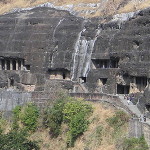
Hailed as one of India’s greatest artistic treasures, Ajanta is the location of some of the finest examples of ancient Indian sculptures and murals, housed in 28 caves that served as a major Buddhist monastery from the second to seventh century BC. Today, the Ajanta Caves are renowned all over the world for their majestic beauty and is a UNESCO World Heritage Site.
At Ajanta, the caves hewn out of the horse-shoe shaped stone cliffs surrounding the River Waghora are an important heritage site, allowing viewers to glimpse the amazing skill of ancient muralists and sculptors. These caves were chiselled out by Buddhist monks between 200 BC and 650 AD as ‘chaityas’ (prayer halls) and ‘viharas’ (monasteries), and contain exquisite frescoes and fine sculptures.
Ajanta caves are classified in two phases known as the Hinayana phase and the Mahayana phase. The former phase depicts scenes in which Lord Buddha was worshipped through some specific symbols whereas in the latter phase people believed that the deity had a definite structure and started worshipping him.
Some of the well known caves are as follows.
- Cave 1 consists of some of the finest painting specimens, particularly the two bodhisattvas of Padmapani and Vajrapani and an impressive seated Buddha sculpture. Beneath his statue is placed the Wheel of Life which symbolised the teachings of karma and rebirth by Buddha.
- Cave 2 is its beautiful ceiling painted to resemble a tent and its lovely animated sculptures. The walls of the cave are decorated with intricate patterns depicting scenes of Gautama Buddha’s birth.
- Cave 9 contains sculptures, remarkably preserved frescoes as well.
- Cave 11 represents scenes from the early stage of Buddha’s life. In this cave the sculpture of Lord Buddha is attached to a stupa which is a blend of both image and stupa worship.
- In Cave 12 and Cave 13 one can view the beautiful paintings that glow softly in the dark and gasp at the life-size and miniature sculptures.
- Cave 15 and Cave 16 explain the pictorial legend, pointing out some of the more amazing aspects of the paintings and sculptures that transform the rocky cave walls.
- Cave 17 with its exquisite murals portraying devotees with offerings in the Royal Procession,
- Cave 19 with some astounding sculptures of Buddha, lion heads and riders,
- Cave 26with its impressive carvings from Lord Buddha’s life.
The Caves are open from 9:00 am to 5:30 pm. on all days and remain closed on Monday, but are open on all National Holiday’s.
.
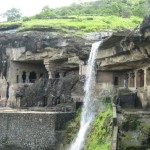
The Ellora caves, locally known as ‘Verul Leni’ is located on the Aurangabad-Chalisgaon road at a distance of 30 km north-northwest of Aurangabad. The name Ellora itself inspires everyone as it represents one of the largest rock-hewn monastic-temple complexes in the entire world. Ellora is also world famous for the largest single monolithic excavation in the world, the great Kailasa (Cave 16). The visit to these caves is enjoyed maximum during monsoon, when every stream is filled with rainwater, and the entire environ is lush green. The monsoon is not only a season of rains in this part, the local visitors are attracted to visit these ideal locations to have a glimpse of the mother nature in full bloom.
The caves are hewn out of the volcanic basaltic formation of Maharasthra, known as ‘Deccan Trap’, the term trap being of Scandinavian origin representing the step like formation of the volcanic deposits. The rock formation, on weathering has given rise to the appearance of terraces with flat summits. At Ellora, one can also have a glimpse of the channels (near Cave 32) through which the volcanic lava once flowed. These channels, due to overheating, have a characteristic brownish red colour. Similar rock was used in the construction of the Grishneshwar Temple nearby and also utilised for the flooring of the pathways at Bibi-ka-Maqbara.
The caves are excavated in the scarp of a large plateau, running in a north-south direction for nearly 2 km, the scarp being in the form of a semi-circle, the Buddhist group at the right arc on the south, while the Jaina group at the left arc on the north and the Brahmanical group at the centre.
Open from sunrise to sunset
Remains closed on Tuesday
Entrance Fee:
Citizens of India and visitors of SAARC (Bangladesh, Nepal, Bhutan, Sri Lanka, Pakistan, Maldives and Afghanistan) and BIMSTEC Countries (Bangladesh, Nepal, Bhutan, Sri Lanka, Thailand and Myanmar) – Rs. 10 per head.
Others: US $ 5 or Indian Rs. 250/- per head
(Children up to 15 years free)
.
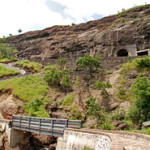
Magnificent Ajanta and Ellora Caves have overshadowed the values of another complex of beautiful cave temples – Aurangabad Caves. These caves contain some of the most beautiful sculptures known to be created by Indian artists of classical period.
Caves are located few kilometres north from Aurangabad city, in steep slopes of a hill running roughly from east to west, some 20 m above the surrounding plain. They were unknown to Europeans until middle of 19th century.
In total here are 12 Buddhist caves divided in three groups. The westernmost caves comprise the first group and are numbered from 1 to 5. Second group is located some 500 m further to the east and includes caves 6 to 9. The easternmost group is located 1 km further to the east and includes caves 10 – 12. Caves are carved in cliff in time period from 2nd – 3rd century AD to 7th century AD. The oldest caves are 1 and 3, possibly excavated in 2nd – 3rd century AD.
.
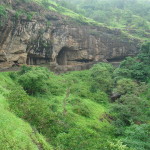
The Pitalkhora or “Brazen Glen” is located at a distance of nearly 25 km west of Kannad, and nearly 40 km west of Ellora caves. On the Aurangabad – Chalisgaon road, one has to take a diversion at Kalimath and travel nearly 4 km to reach the caves. The caves are located in a valley below and one has to ascend the steep steps to reach down. A stream, usually full of water during monsoon greets the visitors’ midway during the descent, and after crossing over through an iron bridge constructed by the ASI, one reaches the caves.
Pitalkhora consisting of 14 Buddhist Caves forms one of the earliest centres of the rock-cut architecture. They are cut in a variety of basalt rock which weathers faster in contrast to other parts in Maharashtra. Out of 14, 4 are chaityagrihas, one housing votive stupas, one apsidal and single cell (5A), and the rest are viharas. All the caves belong to the Hinayana period but the painting executed in the caves are of Mahayana period. The caves are in two groups; the first group consists of 10 caves and second consists of 4 caves. The Chaitya and Monastery Caves in this group have traces of very beautiful paintings of which some are surviving in the former. The inscriptions found here dates from c. 250 B.C. to 3rd – 4th century A.D.
The sculptural representations here are similar to that of found in the stupas of Sanchi, Karla, Nasik, of the same period. As these Caves are carved in somewhat softer and fragile rock, here one can also see examples of ‘ancient conservation’. A feature which needs special mention is the very ingenious arrangement of diverting water that found its way into the cave through cracks; long tunnel like openings were bored into the ceilings and the water was allowed to flow fully into the cave underneath the floor in concealed drain channel cut to lead the water outside near the cave entrance (Cave 4).
.
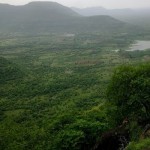
Flora:
Southern tropical dry deciduous forest is the main forest type in this track which includes draught resistant trees like Anjan, Khair, Dhawada. Tree height remains less than 10 mts. Hills tops have Sparse vegetation. Slopes are covered with Euphorbia spp. River valleys support moist zone species such as Arjun and Chandan valleys have got diversified vegetation. In the past efforts are done for afforestation area under various plantation schemes together with intensive soil and water conservation works. Grass lands at hill tops, plain growth have good growth grasses. Thus the diversified vegetation scattered intermittently support rich faunal diversity. Particularly it is good for sloth bear habitat and excellent for birds resident as well as migratory.
Fauna:
Mammals: Chinkara, Sloth bears, Bats, Wild boar, Jungle cat, Monkey, Civet cat, Barking deer, Fox, Jackal, Langoor, Leopard, Nilgai, Wolf etc.
Birds: There are more than 230 species of birds seen in the area. Notable migrants are Cranes, Spoonbills, Storks, Ibis, Pochards, and many other species of Waders. Peafowl has much dominance in the area in addition ground birds such as quail, patridges, Jugale fowl.
Reptiles: Amongest Snakes-Cobra, Krait, Keel backviper, Python, Rat snake are seen. Monitor Lizzard.
How to reach:
- Nearest Airport: Aurangabad (Aurangabad to Kannad 55 Km.),
- By Rail: Chalisgaon on Mumbai-Nagpur rail line (Chalisgaon to Kannad 55 Km.),
- By Road : Nearest town is Kannad 3 Kms. and Chalisgaon is 12 Kms. away
.

Jayakwadi Bird Sanctuary is situated in Aurangabad and Ahamadnagar district in Marathawara region. The presence of the Nathsagar Lake in the bird sanctuary, make the surrounding regions rich in aquatic flora and fauna.
The aquatic vegetation includes chiefly the species of Spyrogyra, Hydrilla, Chara, Potamogeton, Vallisneria etc. Argemone Maxicana and Ipomea Fistulosa are found in the adjoining area. Nearby areas are agricultural irrigated fields and the habitation of the plants and animals has high potency and rich production of aquatic flora and fauna.
Jayakwadi Bird Sanctuary has attracted many species of resident and migrant birds. Almost 200 species of birds can be found in this region, which includes more than 70 species of migratory birds. Out of these, 45 chief species are of international migration. Notable amongst migratory birds are Cranes, Flamingos, Pintails, Wigeon, Shoveller, Brahmany Duck, Pochards, Teals, God Wit, Shauces, Glossy Ibis, etc..
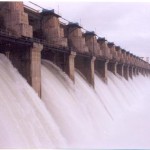
Spreading over an area of 125 hectares, the Jayakwadi Dam provides water to Aurangabad city and surrounding place. Situated on River Godavari, the largest river in Southern India, the reservoir is called Nath Sagar.
The dam is a restricted area and visitors are prohibited from driving their vehicles up to the dam site. Photography is also prohibited in the vicinity of the dam. Visitors should bear this in mind because most of the signboards carrying these instructions are written in the local language, Marathi.
It is located on Godavari river at the site of Jayakawadi village in Paithan taluka of Aurangabad district in Maharashtra state, India.
Foundation was laid by late Prime Minister Lal Bahadur Shastri on 18 October 1965 and Inaugurated by late Prime Minister Indira Gandhi on 24 February 1976..
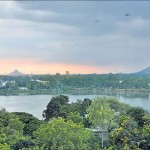
Salim Ali Sarovar (lake) popularly known as Salim Ali Talab is located near Delhi Gate, opposite Himayat Bagh, Aurangabad. It is located in the northern part of the city. During the Mughal period it was known as Khiziri Talab. It has been renamed after the great ornithologist and naturalist Salim Ali.
Salim Ali Talab as it is known in the present times also contains a small bird Sanctuary and a garden maintained by the Aurangabad Municipal Corporation. Boating facilities is also available when the lake is full during the rainy & winter seasons. Recently it was dredged for silt to increase its water holding capacity..
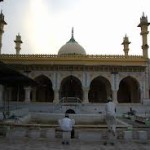
The tomb of Aurangzeb, the sixth Mughal emperor however is exactly the opposite. There is a small marble courtyard and on the right side of the entrance on a raised platform lies the modest grave of Aurangzeb. The emperor in his last years raised the funds for building this simple tomb by knitting caps, copying the Quran and selling them anonymously in the market. The domed gateway and the marble jalis on three sides were erected much later. Open to the air and built with utmost simplicity is how the mighty emperor wanted to be remembered.
Visible in the adjacent plate on the right side is the gateway to the tomb and the tall minarets and the imposing dome behind belong to the mosque which was built later.
.

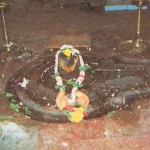
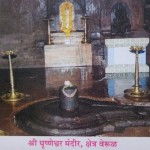
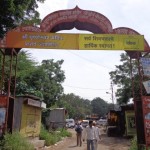
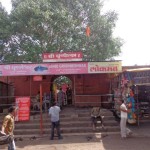
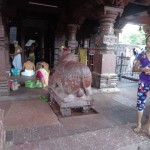
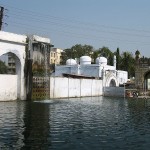
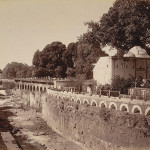
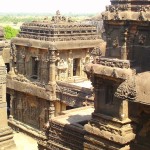
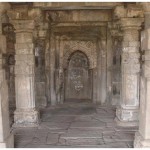
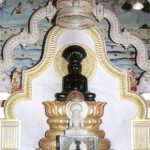
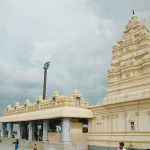
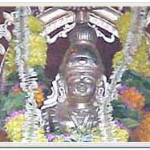
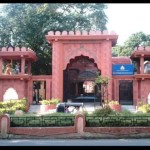
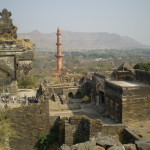
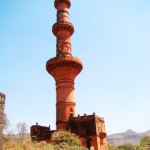
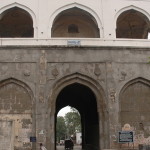
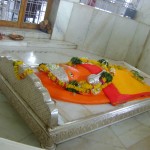
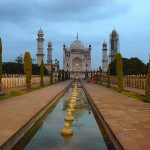
No comments yet.